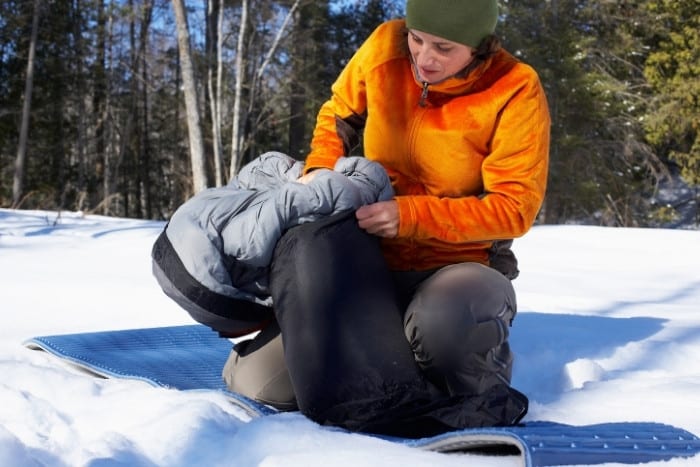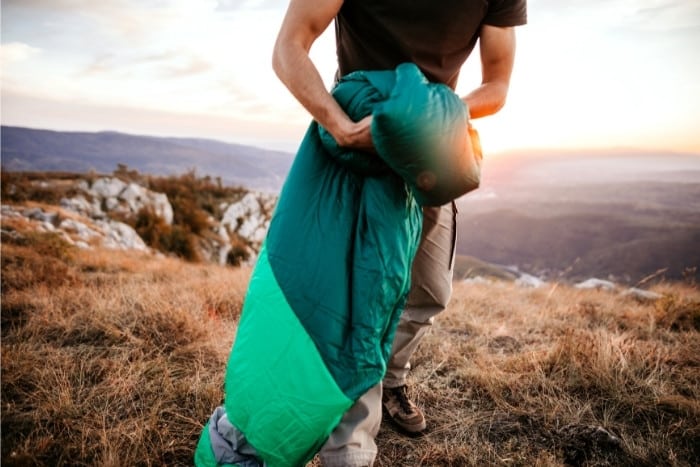You’re considering investing in better camping equipment and want to know if a down sleeping bag is worth the money. Are they really that much better than polyester or other types of synthetic sleeping bags? Are they worth the investment?
Down sleeping bags compress more easily and weigh less than synthetic sleeping bags. They have better loft, and volume can be restored by shaking, beating, or washing. Higher fill powers will keep you warmer. Most down sleeping bags will also last significantly longer, making them a good investment.
Before you spend your hard-earned cash on a new down sleeping bag, here’s what you need to know.
Why Should You Invest in a Down Sleeping Bag?
Down sleeping bags are arguably one of the largest investments you’ll make regarding your camping equipment.
However, they’re also one of the best spends you’ll find if you plan to winter camp.
Compared to synthetic sleeping bags (which are much cheaper), here are the areas where down sleeping bags ultimately shine.
1. Compression
One of the most important items to campers is how unwieldy their pack will be if they have to hike from the car to their campground.
Synthetic sleeping bags don’t have much room for you to compress them down to zip them into a large pack. On the other hand, down sleeping bags are very easily compressed to take up minimal space.
How much can you expect your down sleeping bag to compress compared to your standard synthetic bag? It often takes up about 50 percent less room, so it’s more travel-friendly.
Plus, most of the time, you won’t even need to worry about stuffing it into a compression sack. It naturally takes up less space than synthetic versions of an equally warm sleeping bag.

2. Lightweight
If you look at a synthetic sleeping bag compared to a down sleeping bag, one of the attributes that will stand out the most is how lightweight it is.
The down (the substance found between the goose or duck’s feathers and skin) has more loft. This means space inside the sleeping bag where the down traps your heat.
Because you won’t need as much down to keep you warm as you would a synthetic filler, it won’t weigh as much.
Experienced campers know they’re looking at the warmth-to-weight ratio when deciding on a sleeping bag. Polyester has a much heavier warmth-to-weight ratio compared to down.
If you’re worried about being saddled with pounds that aren’t pulling their weight, then a down sleeping bag is the right move for you.
3. Better Loft
We touched on this idea briefly in the last section, but it deserves its own section. A down sleeping bag has much more loft, meaning it’s fluffier than polyester options.
A higher loft is sometimes also denoted as fill power. Either way, higher numbers mean that it’ll take up more room.
The flip side is that the more room it takes up, the more efficiently it will stand to trap the air.
If you’re planning a winter camping trip where the temperatures will drop below freezing, you’ll want to have a down sleeping bag with more loft or fill power.
4. Restoration
Have you noticed that your sleeping bag isn’t quite as fluffy as it once was? This could spell major trouble if you purchased your down sleeping bag to give you warmth in the winter.
The parts that have lost their loft will transfer your body heat to the cold ground instead of helping to keep you insulated.
The good news is that not all hope is lost if you have a down sleeping bag. One of the easiest ways to restore the loft to your sleeping bag is to shake it up.
Hang it up to the best of your ability and then shake or beat it to get the clumps to redistribute. You may need to manually break some of the clumps depending on how long it’s been since you last did this.
Another method to break up the clumps is to place the sleeping bag in a front-loading dryer. Use only the air setting and add a few tennis balls.
While running your dryer like this may be noisy, the tennis balls work effectively to break up those clumps faster than you could do by hand.

5. Washing
You’ll only need to wash your down sleeping bag every once in a while. Consult the care instructions upon purchase, but many can be hand-washed in the tub or a front-load washing machine.
If you use a washing machine, run it on a gentle cycle to prevent damage to the bag. You’ll also need to unzip it and remove the drawcords to keep the bag from tearing.
Overall, it’s better not to risk placing it in the washing machine if you can avoid it. Also, keep in mind that you’ll need to wash it well before your next camping trip so that it has adequate time to dry.
A damp sleeping bag won’t offer any form of insulation for you in freezing temperatures. You’ll be even colder trying to snuggle up in a wet sleeping bag!
6. Longevity
Synthetic sleeping bags are cheaper, but how long will they last you? Down tends to be a much longer-lasting material.
When taken care of properly, many campers boast that they can get more than a decade out of their down sleeping bag.
It could last even longer if you have a higher fill power designed for sub-freezing temperatures. On the other hand, polyester materials won’t last nearly as long.
Synthetic sleeping bags typically last only a few years when used in the same capacity. Plus, there aren’t as many options for you to revive a polyester-filled sleeping bag as there are for down sleeping bags.
If you find that your down sleeping bag isn’t as fluffy as you’d like it to be after a few years of wear, most manufacturers are willing to take another look at it.
They will often add more down to fluff up the bag if you send it back in. This can score you another few years of life out of the same sleeping bag instead of having to retire it.
Final Thoughts
Down sleeping bags are excellent options if you want something that keeps you warm, cozy, and comfortable all winter long.
They’re much easier to refresh and last longer than the standard synthetic sleeping bag. Manufacturers may even be able to help you extend its lifespan by adding more loft years down the road.
If you’re considering investing in your camping gear for four-season camping, you can’t go wrong with a down sleeping bag.
